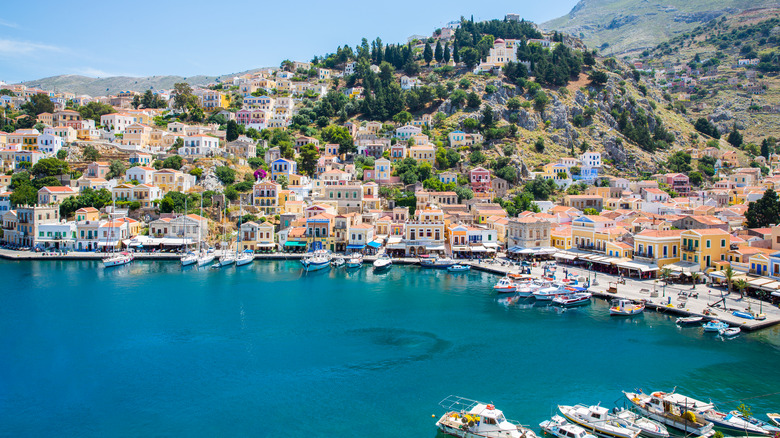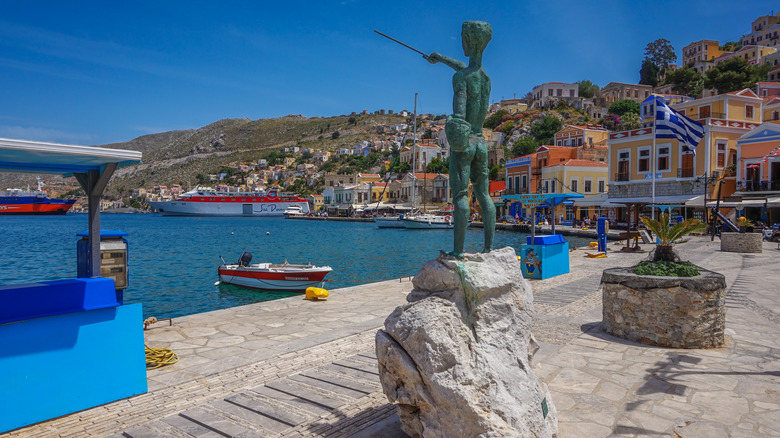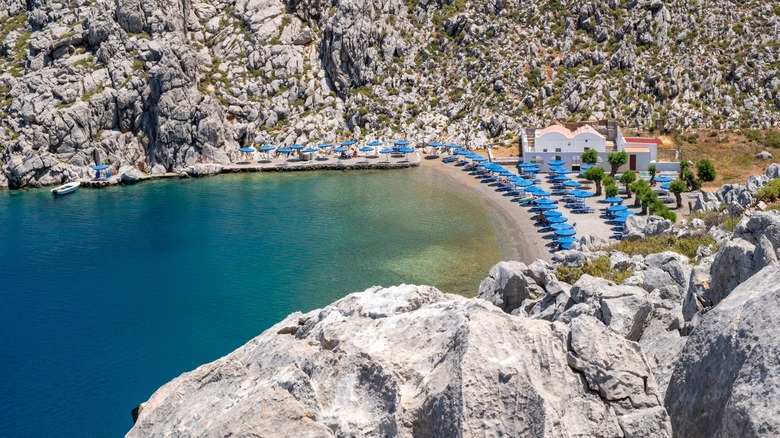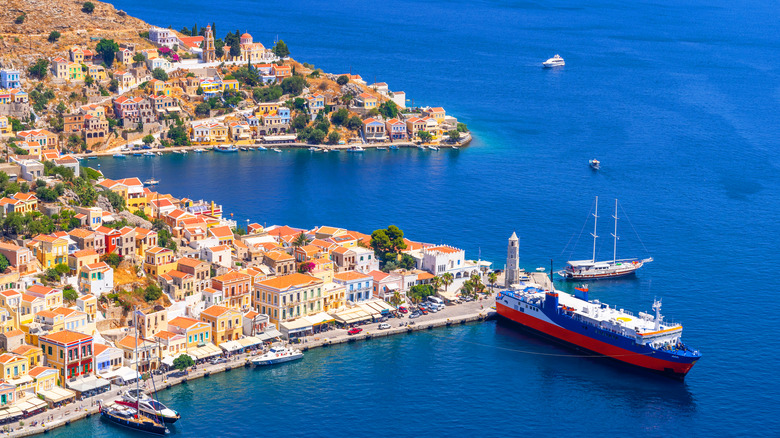Pastel Colored Buildings Make One Of Greece's Most Underrated Islands Look Like A Fairytale
Fanciful descriptions of Symi may appear too good to be true. Pastel-painted abodes adorn a hillside that hugs a pristine horseshoe-shaped harbor? Sounds more Disney-esque than true-to-life. The catch is, the (admittedly) cliché narrative that has long defined the Greek island is spot-on accurate. That's due, at least in part, to strict regulations that govern the island's architecture right down to minute details like color and adornments. Formed in the 1970s, the oversight agency, Archaeologia, was established at the urging of a forward-thinking Symi native who realized, before it was too late, that burgeoning tourism was about to take a toll on his homeland. John Farmakides, who had long since migrated to the United States, noticed how unbridled tourism was affecting the authenticity of nearby Greek islands and reached out to the Greek Ministry of Culture about establishing standards to protect Symi's neoclassical architecture, some of which had fallen into disrepair and was at risk of being replaced with modern buildings.
For centuries, Symi prospered as a commercial center for a lucrative sponge-fishing industry. At the turn of the 20th century, the tiny island outpaced its much larger neighbor Rhodes as an economic powerhouse, drawing wealthy sponge merchants who built grand mansions to live in while overseeing their empires. Then a series of events, including a decades-long occupation by Italian forces and the demise of natural sponge products in favor of manufactured varieties, changed Symi's fortunes, prompting a mass exodus as residents left the island to pursue offshore livelihoods. By reaching out to the ministry of culture about establishing preservation standards in the 1970s, Farmakides is arguably responsible for the fairy tale vision that comes into view as ferries from nearby islands approach Symi Harbor.
Symi is a tiny island with big appeal
By some accounts, it's that initial view that casts the spell, coaxing otherwise reasonable people to throw caution to the wind and move to Symi permanently. It's not difficult to imagine. Thanks to Farmakides' efforts, homes that may otherwise have fallen into ruin have been lovingly restored to their original grandeur. Even new construction has to meet architectural standards to blend with the spellbinding aesthetic that makes visitors fall in love at first sight. The port of Symi — also known as Symi Town — consists of two villages: Gialos and Chorio. As the ferry pulls into port, you'll notice Roloi, an imposing clock tower in Gialos, presiding over the entrance to the harbor. Straight ahead, "Michalakis," a sculpture of a young fisherman about to cast a line, welcomes arriving visitors.
With ferry service connecting Symi to Rhodes in 90 minutes or less — ferries are actually more convenient than planes for island-hopping around Greece — the 23-acre island is a popular day trip destination. The narrow streets of Symi Town are packed with shops, cafés, and tavernas. For an authentic keepsake, keep an eye out for shops selling Symian sponges. While the industry that brought wealth to Symi in the 18th century is no longer the economic powerhouse it once was, the natural loofahs are still available on the island.
Head to the Nautical Museum of Simi where maps, tools, and divers' suits offer a glimpse into the once-thriving sponge-fishing industry. A few miles southwest of Symi Town, the Monastery of Prophet Elias sits perched on a hillside. The single-chamber structure houses a few well-preserved frescoes dating to the early 18th century. About a 15-minute walk from Symi Town, NOS Beach (Nautical Club of Symi) is popular and easily accessible.
Symi's beaches are remote, but gorgeous
Symi boasts plenty of gorgeous beaches, but there's a catch. Most of them are remote, accessible only by a long hike or via water taxi. Which can be a good thing. Nanou Beach is like something out of a movie set. Do yourself a favor and hire a water taxi. The ride is only a few minutes and it's much more relaxing than the long hike it takes to arrive by foot. The crescent-shaped beach sits at the foot of dramatic cliffs. There's a taverna and beach gear rentals are on offer. Although the trail to St. Nicholas Beach isn't difficult, it is a long and winding road. Popular among birdwatchers, hiking the 3.1-mile trail takes about an hour and a half end to end but, again, a water taxi will get you there and back, no sweat. There's a family-run beach bar and chaise longues are available for rent.
Located about 10 miles from the town of Symi on the southeast coast of the island, Marathounda Beach is in a protected bay. It's also only a short walk from the Monastery of the Archangel Michael at Panormitis. A favorite destination for visitors, it's believed the existing structure was built sometime around the 15th century, probably on top of the ruins of an ancient temple. A collection of artifacts on display at the monastery's two on-site museums run the gamut from silver icons and religious items relics tied to Symi's cultural heritage.
Getting to Symi is worth the effort
There's no airport on Symi so, unless you own or charter a boat, prepare to arrive via ferry from Rhodes. If you're coming from mainland Greece, you have a couple of options. Either a 17-hour ferry ride from Athens or a flight to the nearby island of Rhodes followed by a one-hour (give or take depending on the company) ferry crossing.
You won't find any big resorts or international brands on the island, but there are a few good local hotels. Open seasonally, Pedi Beach Hotel gets high marks from visitors who remark on its bayfront setting and top-notch service. With just 10 rooms in its main building, The Old Markets is a centuries-old national monument. Former shops in the one-time community marketplace have been converted to guest rooms in a manner that respects the structure's architectural heritage. Private home and apartment rentals are also a popular lodging choice among visitors.
When it comes to sampling the local cuisine, think seafood. Symian shrimp — sautéed in a bit of olive oil and lemon or fried — is the local speciality. You won't go wrong ducking into a locally run taverna for a bite. It's a bit of an uphill hike to Haritomeni Taverna, but the expansive harbor views are with the effort. For a romantic evening, head to The Secret Garden, and be sure to find time to experience an authentic ouzeria. Located on the harbor front, Elpida Cafe is a prime spot to sip an aperitif while watching the world go by.



